Dell XPS 13 2-in-1 7390 Review: A convertible with very few compromises - branchcolood
Call the Dell XPS 13 2-in-1 the triple threat. IT offers awesome performance in an amazingly tiny packet (and it's convertible, too). It's also one of the first laptops to sport Intel's new 10th-gen Ice Lake Core i7-1065G7, founded along a original 10nm process technology.
The XPS 13 2-in-1 also has few features that are likely to steam dormie some fans. That potential drama aside, this laptop computer is just about perfect.
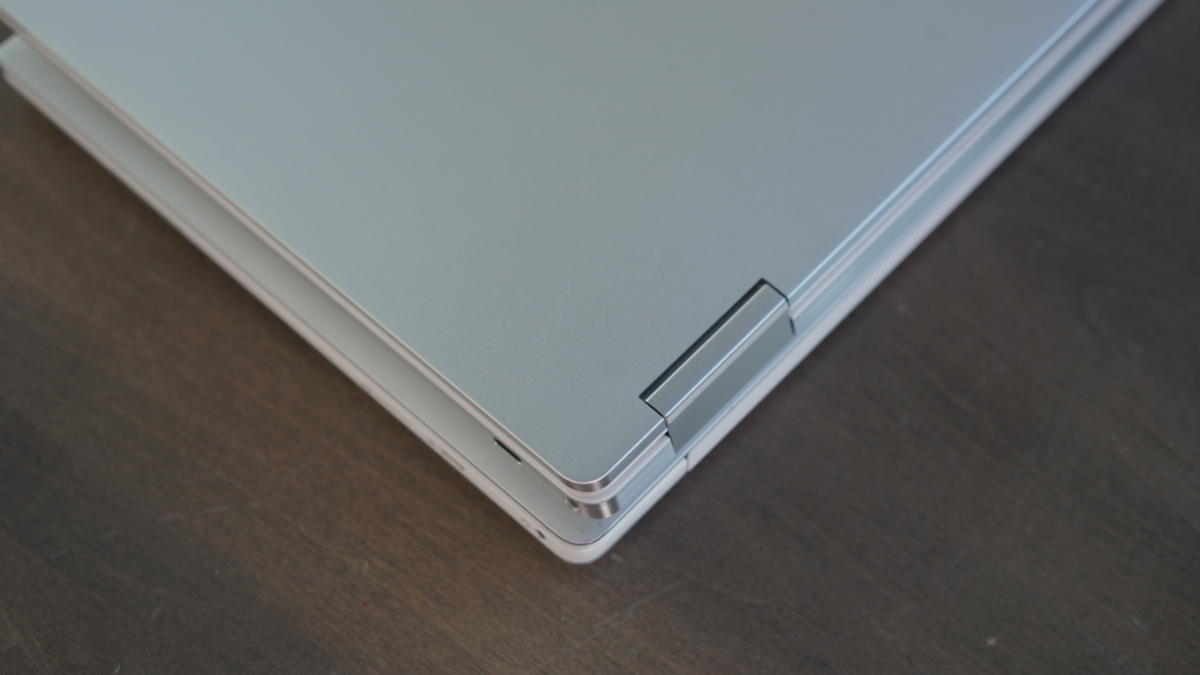 Gordon Mah Ung
Gordon Mah Ung The 360-degree hinge tells you the XPS 13 2-in-1 ass be flipped back.
XPS 13 2-in-1 Specs
We'll showtime by egg laying out the major specs for the XPS 13 2-in-1, including:
CPU: Intel Deoxyephedrine Lake 10th-gen quad-nitty-gritty Core i7-1065G7 (10nm process)
GPU: Intel integrated Iris Advantageous nontextual matter
Drive in: 16GB LPDDR4X/3733
SSD: 512GB Toshiba/Kioxia BG4 NVMe PCIe, for good soldered
Wireless: WiFi 6
Dimensions (inches): 11.7 x 8.2 x about a quarter-inch to half-inch thick
Screen: 13.4-inch, 1920×1200, 16:10 IPS, rated at 500 nits and 90 percent of DCI-P3 color gamut. Touch- and pen-enabled, with Gorilla gorilla Glass 5.
Ports: Two Thunderbolt 3 ports, 3.5mm analog headset jack,microSD.
On the spec list, thither are four good things and two controversial things we want to point out. Apparently the new Mainframe is good, but we recollect the Intel Sword lily Nonnegative graphics deserves a shout-out likewise. We know from our performance preview of Intel Ice Lake it's a big step up over standard UHD artwork.
The RAM is also worth noting. LPDDR4X memory has been just about for about four years now (at least the non-X version), but it's just finally making its way into PC laptops thanks to Intel's newest CPU, which supports it. LPDDR4X in essence means higher clock speeds, big computer storage modules, and lower index consumption.
Finally, the panel Dell used is to exist applauded as fit. PC laptops have pole-handled been peer-pressured into a universal 16:9 aspect ratio. That's great for videos, but for actual work, where taller screens are preferred, information technology's atrocious. Apple's MacBook habituate 16:10, and Microsoft's 3:2 on the Surface line is just some perfect barring the unlikely return of retro 4:3 square monitors. The XPS 13 2-in-1's 16:10 International Relations and Security Network't 3:2, merely that somewhat taller aspect ratio gives you slightly much available screen area.
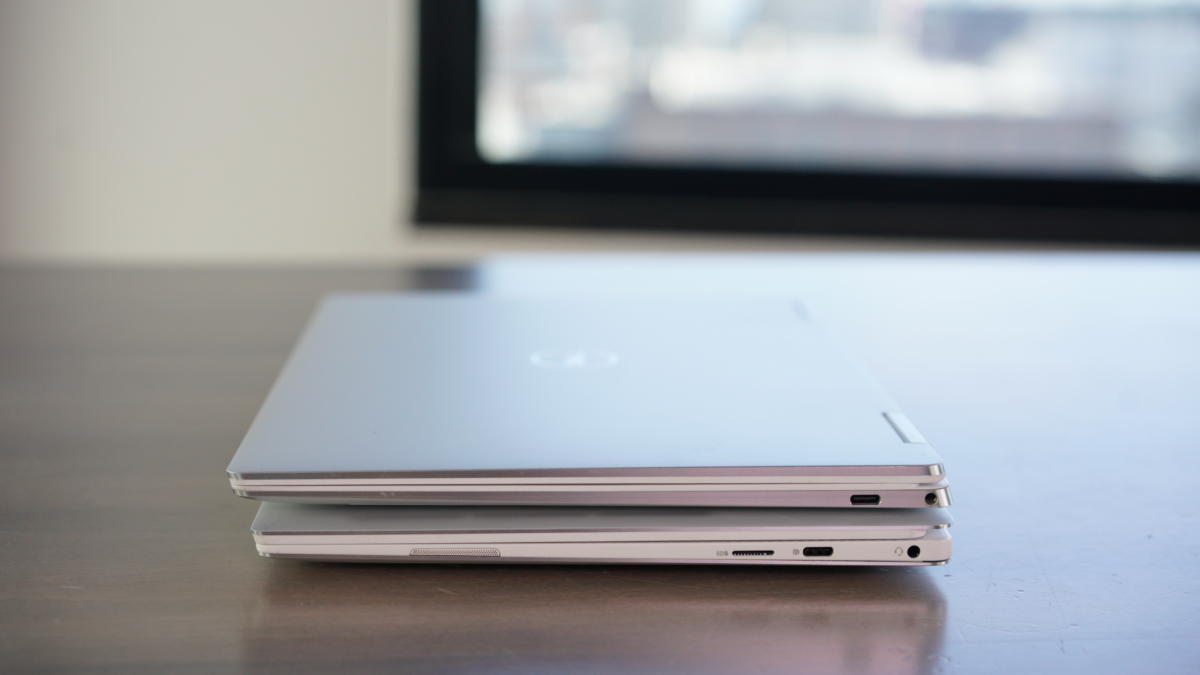 Gordon Mah Ung
Gordon Mah Ung The XPS 13 2-in-1 7390 on top of a Dell XPS 13 9380. The body is narrower but besides slightly deeper to suit the superior 16:10 aspect ratio screen.
Happening the disconfirming root, we'll channelize out the port arrangements. There are two Thunderbolt 3 ports and a headphone jack. Missing is the all important square USB Type-A. Dell continues to say it couldn't lie with without devising the laptop thicker.
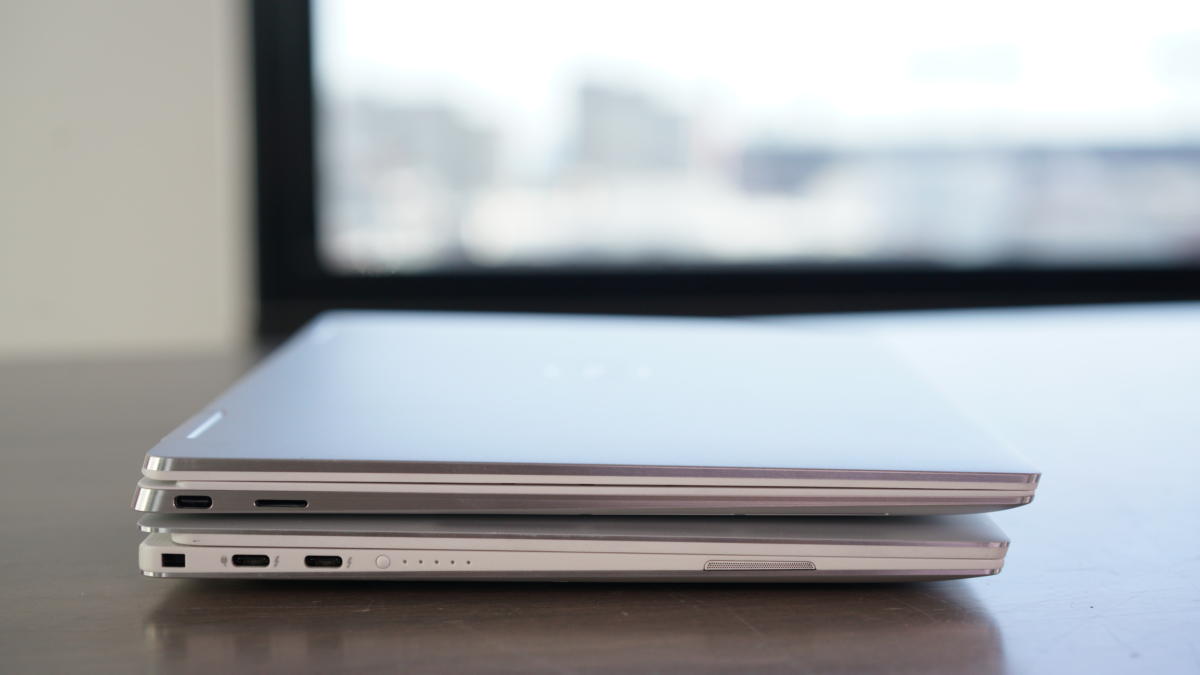 Gordon Mah Ung
Gordon Mah Ung Nope, thither's no USB Type A on either of the XPS 13 versions above, so make your peace or buy a different laptop..
The hold up point that's triggered some is the use of soldered storage. The XPS 13 2-in-1 we saw features a 512GB Toshiba BG4 SSD soldered in real time on the motherboard. Wherefore? Dell officials have told PCWorld it's for place and z-tiptop restraints. Yes, others have jammed M.2 removable drives into insanely withered laptops, but Dell sticks to its guns and says all square millimeter counts when you're trying to jam ironware into a tiny laptop computer—and make it fast, too.
To be blond, while PC enthusiasts love their ascent paths, same few users actually upgrade their laptop drives. Just make sure when you buy that laptop computer to get an SSD capacity that will last a while.
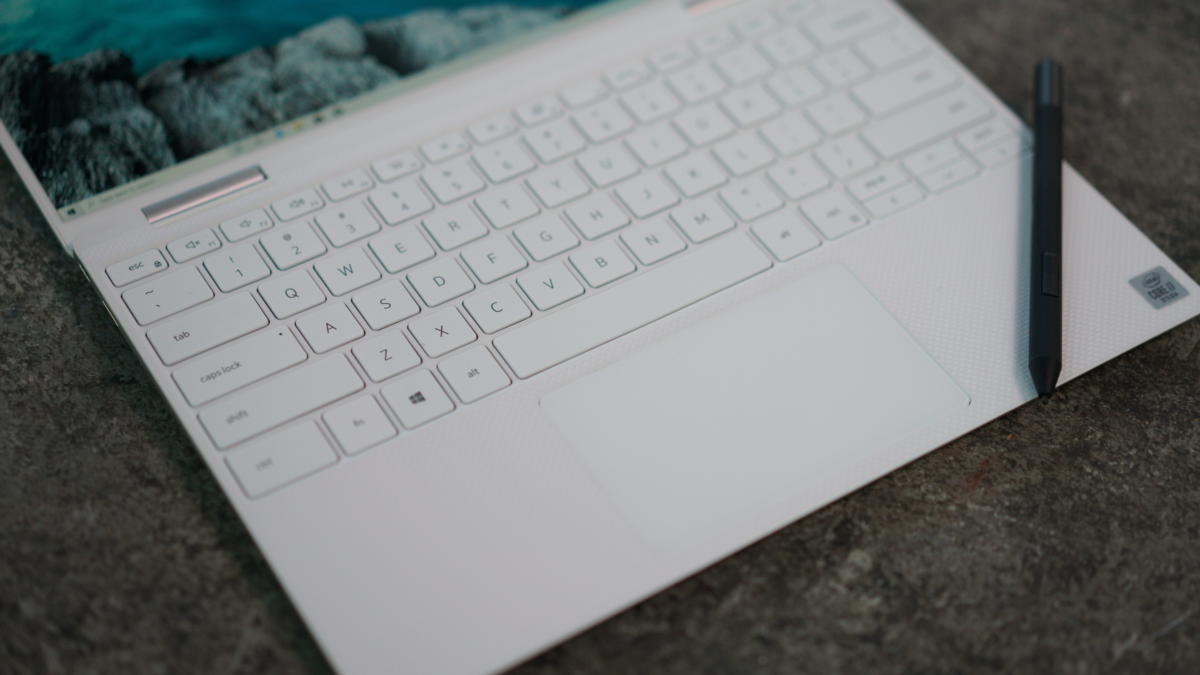 Gordon Mah Ung
Gordon Mah Ung The keyboard uses Dell's 2n- gen MagLev applied science, which is basically Mac-wish (without the reported bankruptcy rates).
Keyboard and trackpad
With the redesigned XPS 13 2-in-1, Dell shrinks down the "MagLev" keyboard. First misused on its XPS 13 2-in-1 two years ago, it uses magnets to repel the keys second up once they've been dispirited. The 2nd-gen keyboard is quieter, "softer," and well-nig 25 percent thinner than a conventional laptop computer keyboard. IT's also, frankly, like a MacBook keyboard in its limited travel and feel.
Is it bad? No, but for folk who are revolted by low- to no more-trip keyboards, this won't please you. We will aver—in typing tests against the traditionalistic XPS 13 9380 and the HP Spectre x360 13t (2019), our typing speed was near the indistinguishable along all three. Whatsoever perceptions that this keyboard doesn't "feel" right may be strictly subjective.
The keyboard features a brimming-pad finger print reader in a rectangular spot above the backspace key. The lecturer is the size of a key and in a bit of an curious location, as you may occasionally fourth estate it spell fat-fingering for either the backspace or the delete key.
The trackpad is glass, with a very light matte feel. Its proportions are correct, and it supports Microsoft's Precision Touchpad requirements. Basically, it's a good trackpad.
 Gordon Mah Ung
Gordon Mah Ung The perfect form factor
Laptop form factors are a very individual choice. I've away through a Aboveground phase, where I thought Microsoft's tablet-first base, laptop-second concept was pretty peachy. Eventually I discovered that I rarely used our Surface as a tablet. And yeah, information technology was plain horrible to use on my lap.
I've since come to prefer 360-degree designs the likes of Lenovo's Yoga, HP's many flavors of x360, and others. They basically spirit and function impartial the likes of a typical clamshell design, and for the few times a twelvemonth when you demand a tablet, you just tack the keyboard around. Because the keyboard is attached, there's No magnet to hand down way and send your pad clattering to the floor, and no need to learn origami to close information technology back up. The 360 designs also works great for presentations in A-frame manner.
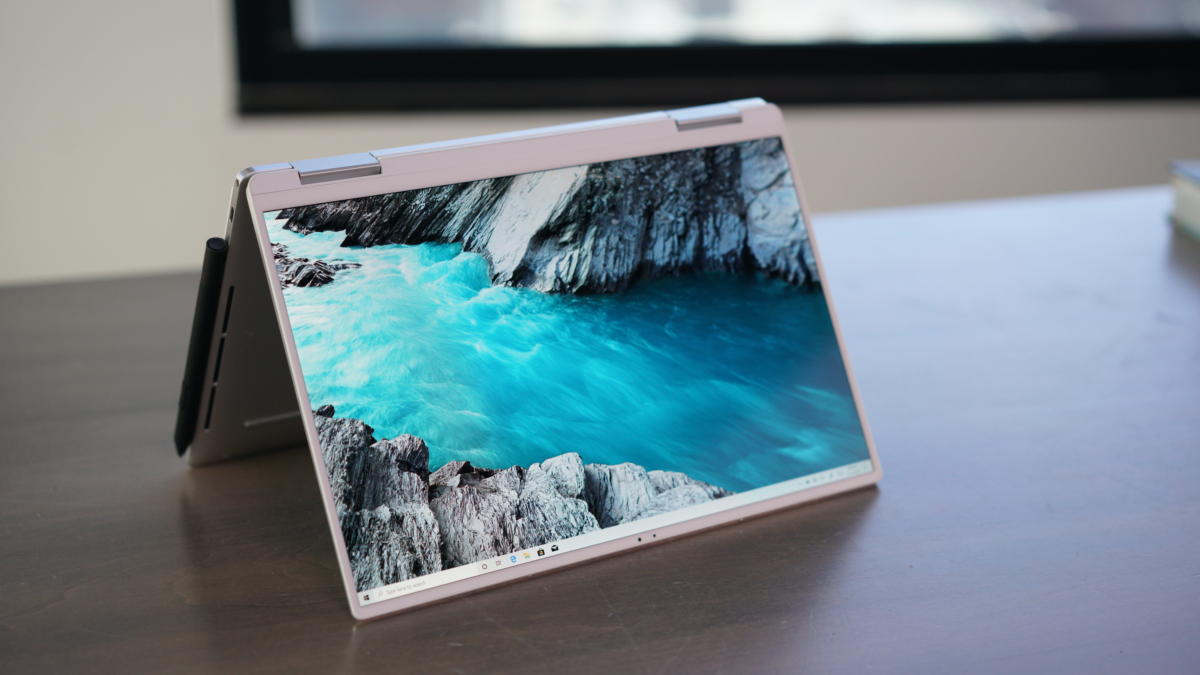 Gordon Mah Ung
Gordon Mah Ung The lonesome real via media has been carrying out. Most of the 360 laptop designs we've tested quit execution compared to quasi-sized and spec-ed clamshell. For example, the premature two generations of the XPS 13 2-in-1 featured Core M-assort CPUs and were fanless. With the XPS 13 2-in-1, Dell makes no such performance compromise, fitting in a new vapor chamber design with ii fans to keep it all cool. The end result is top-of-the-line performance.
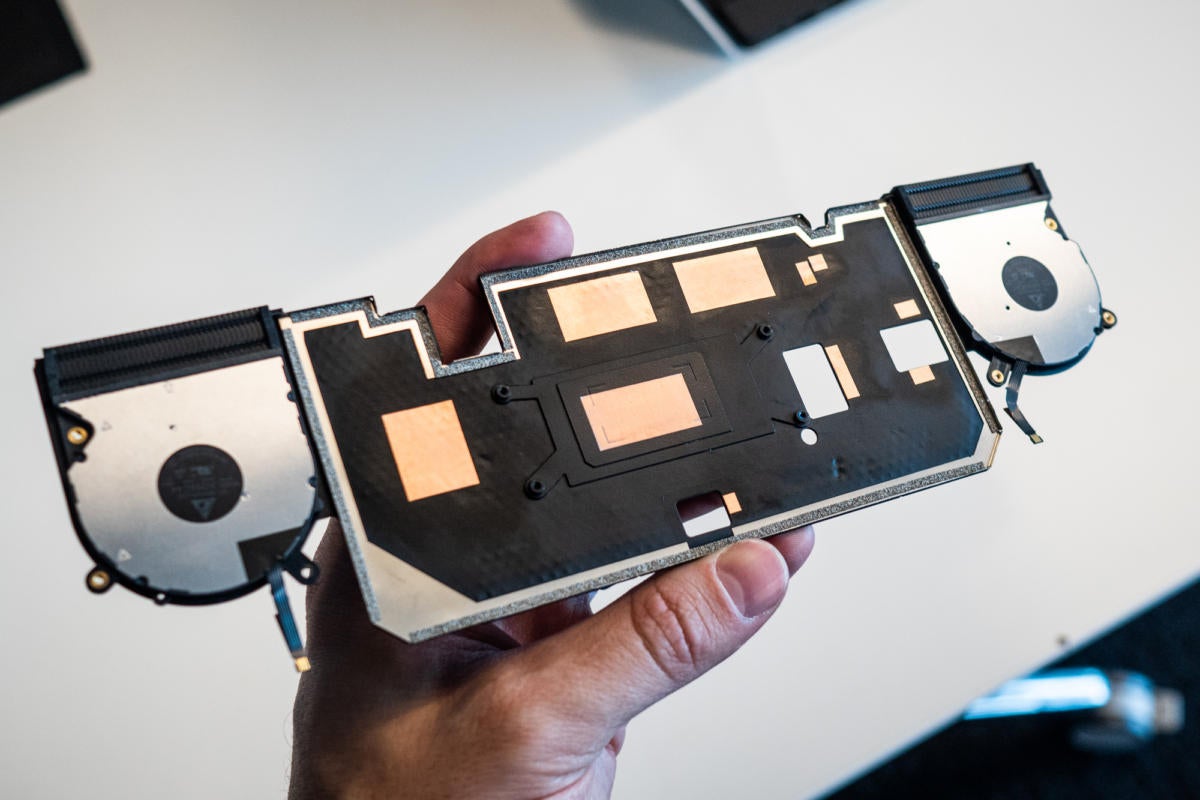 Adam Patrick James Murray
Adam Patrick James Murray The new XPS 13 2-in-1 features bull vapor chambers and dual fans, a major change from the former iteration with twofold-nitty-gritty passive cooling.
XPS 13 2-in-1 7390 Central processing unit performance
Our first prove is Maxon's Cinebench R15 benchmark. It's a 3D rendering benchmark built on an older engine used in its commercial Cinema4D product. Intel has shied by from Cinebench and such 3D rendering public presentation tests because, well, who the hell does 3D modelling on a tiny laptop?! While we agree it's not typical, information technology also hasn't been feasible previously. With today's multi-core laptops, it's actually achievable.
For our test, we ran Cinebench with the Dell XPS 13 2-in-1 in its stock manakin out of the box seat—and also ran it victimization the performance manner pick in the Dell Power usefulness.
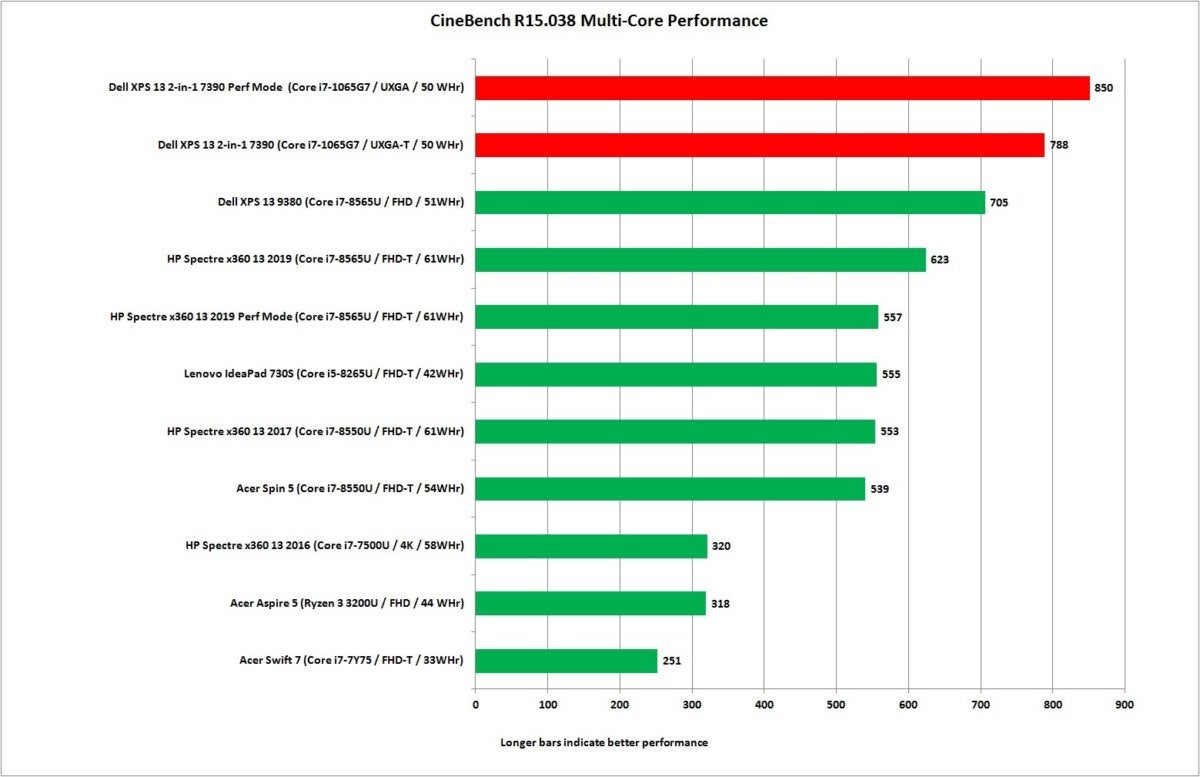 IDG
IDG Intel's 10th-gen 10nm Ice Lake CPU outperforms previous contemporaries CPUs.
Performance of multi-threaded work is simply impressive, with the stock laptop outperforming the clamshell Dell XPS 13 9380 by 11 percent connected stock settings and a blistering 20 pct when pose to its performance mode.
Most applications rarely stress more than than a single thread, though, so we also ran Cinebench R15 in that mode. The Dell XPS 13 2-in-1 7390 again comes out on top when set to its carrying out mood, and it posts a very close third in defulat mode—losing to its sibling, the XPS 13. The performance is actually complete fairly similar, which has long light-emitting diode us to say that for most tasks, such As browsing and Office, most will never be able to "look" the difference between most modern laptops.
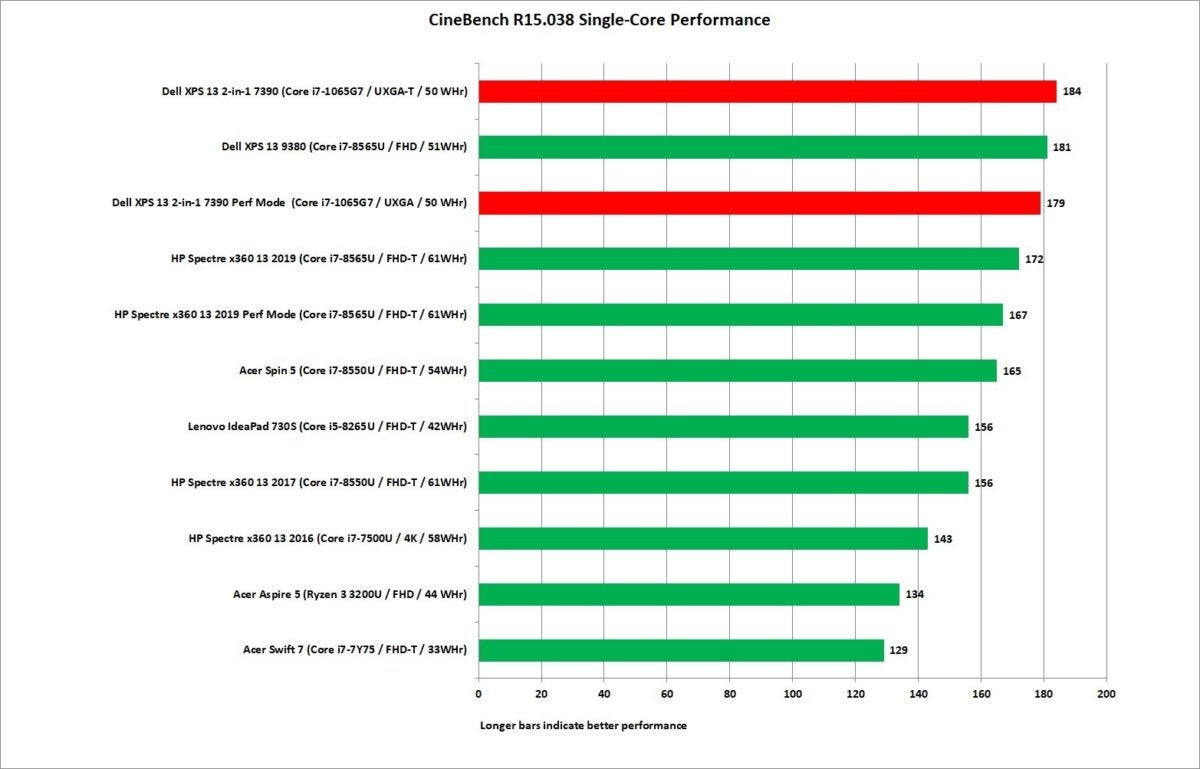 IDG
IDG The Dell XPS 13 2-in-1 "wins" merely we frankly don't think most could ever so feel the dispute.
To pick up if that holds up, we also extend to UL's PCMark 8 Work Straight. The mental testing simulates figure out application tasks victimisation the CPU (conventional) rather than exploitation the graphics chip. Again, the Dell XPS 13 2-in-1 does not disappoint, winning both top spots with its two dependable modes. Just again, you'd really be rocklike-pressed to flavor the deviation between a really fast laptop and one that's "sportsmanlike" decently fast.
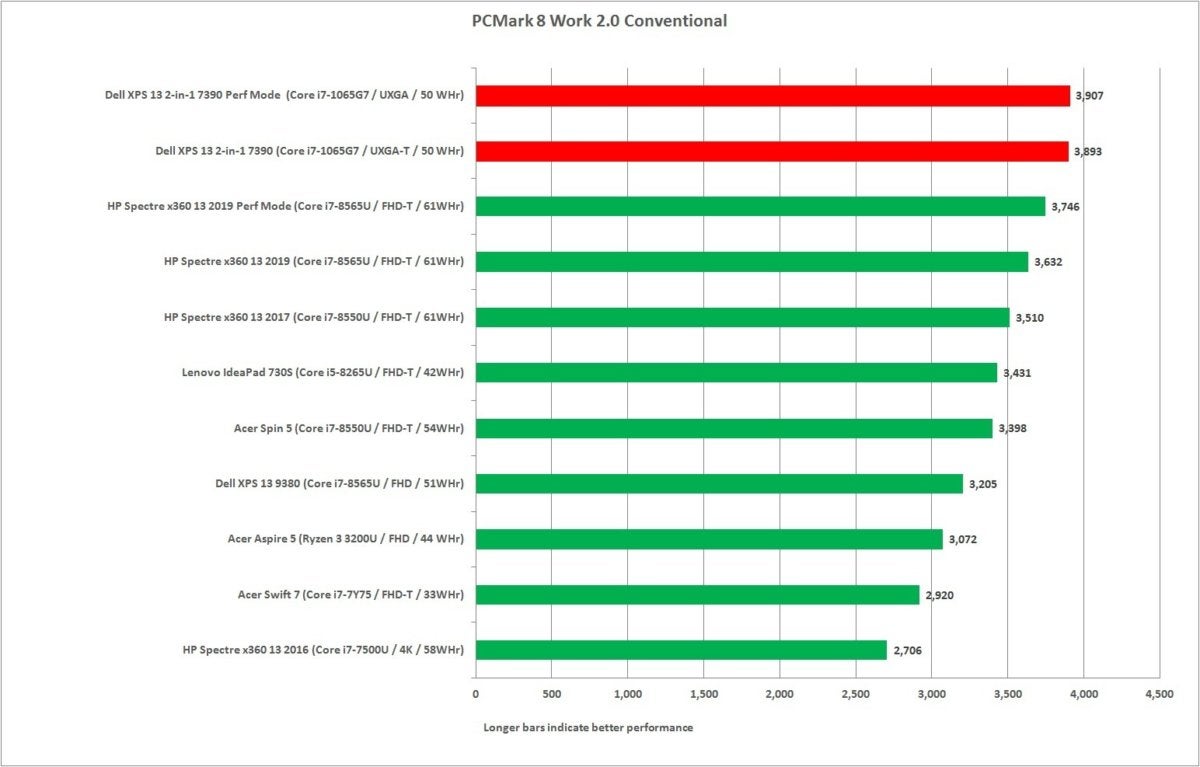 IDG
IDG PCMark 8 puts the Dingle ahead, but we don't conceive most could tell the divergence.
Our last CPU-focused trial uses an older version of the autonomous HandBrake encoder to change over a 30GB 1080p file in using the Android Tablet preset. The screen loves multi-core group laptops and also takes a important amount of time to complete, so you stool consider this a pretty handy stress test of a CPU.
The XPS 13 2-in-1 comes out on top off when set to performance mode. When it's non, the XPS 13 2-in-1 is basically tied with other uppermost-end 8th-gen Whiskey Lake laptops. We should also note that the version of HandBrake we purpose is older and uses mostly conventional methods. Newer methods that can use the GPU and its Flying Synchronize module should put the Dell significantly ahead of the backpack.
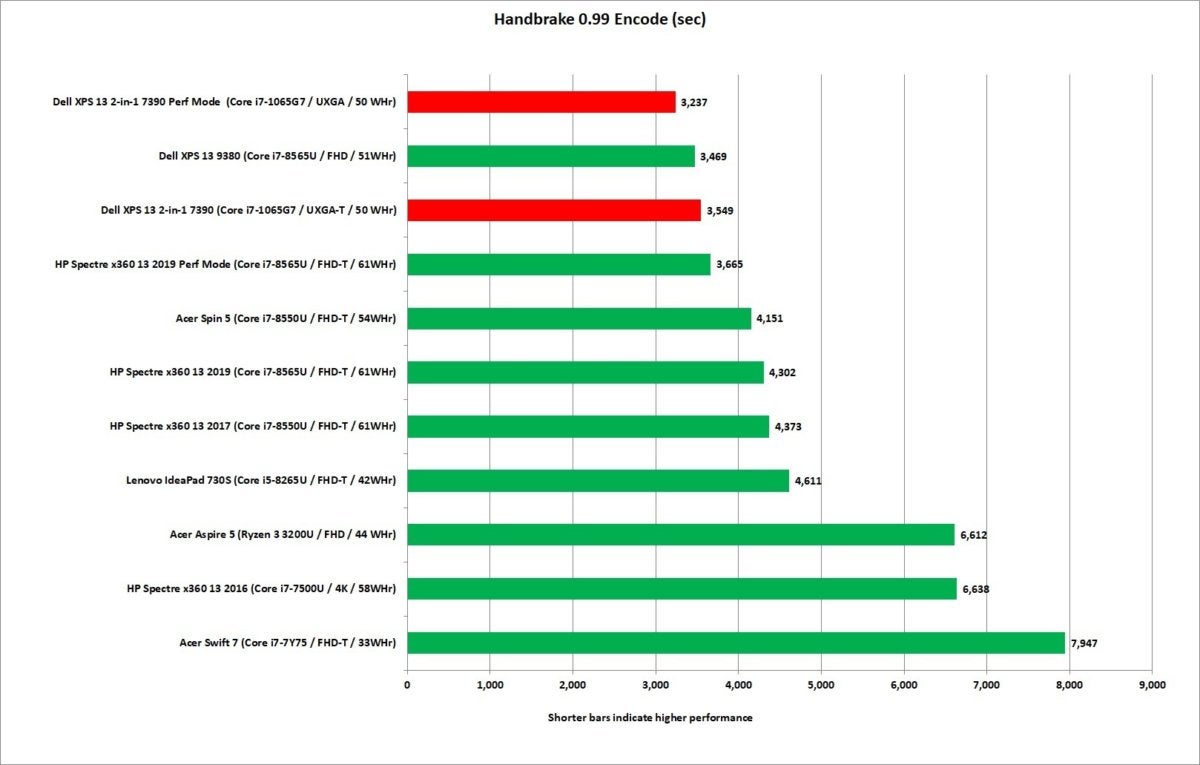 IDG
IDG Our HandBrake test runs a laptop hard for just about an hour.
XPS 13 2-in-1 graphics carrying into action
Mostly, the 10th-gen Ice Lake CPU in the XPS 13 2-in-1 offers scarce additive improvements in CPU trading operations (unless you gravel specialized instruction support much as AVX512, Deciliter Boost or encryption). But the GPU side plainly sings day in and day out.
You can see this below in UL's SkyDiver test, which simulates graphics performance for hoy gaming tasks. You're basically looking at at a 100-percent increase in performance with Intel's Iris Plus graphics. Whatever of that comes from the increased memory bandwidth from the newer RAM LPDDR4X, and some of that comes from the vastly improved graphics cores. Intel graphics is suddenly virtually respectable, and somewhat competitive with Nvidia's MX150 discrete nontextual matter. We say "almost" because it's not like you'll be playing the newest, most intensive titles at 1080p at 60 fps—maybe 30 Federal Protective Service at low settings. Most would likely prefer 720p and medium to low settings for smoother gaming.
Basically, we'd say Iris Plus nontextual matter is acceptable for esports-level of gaming. If you want higher frame rates, we'd recommend coupling the XPS 13 2-in-1 with an eGPU Thunderbolt 3 cabinet.
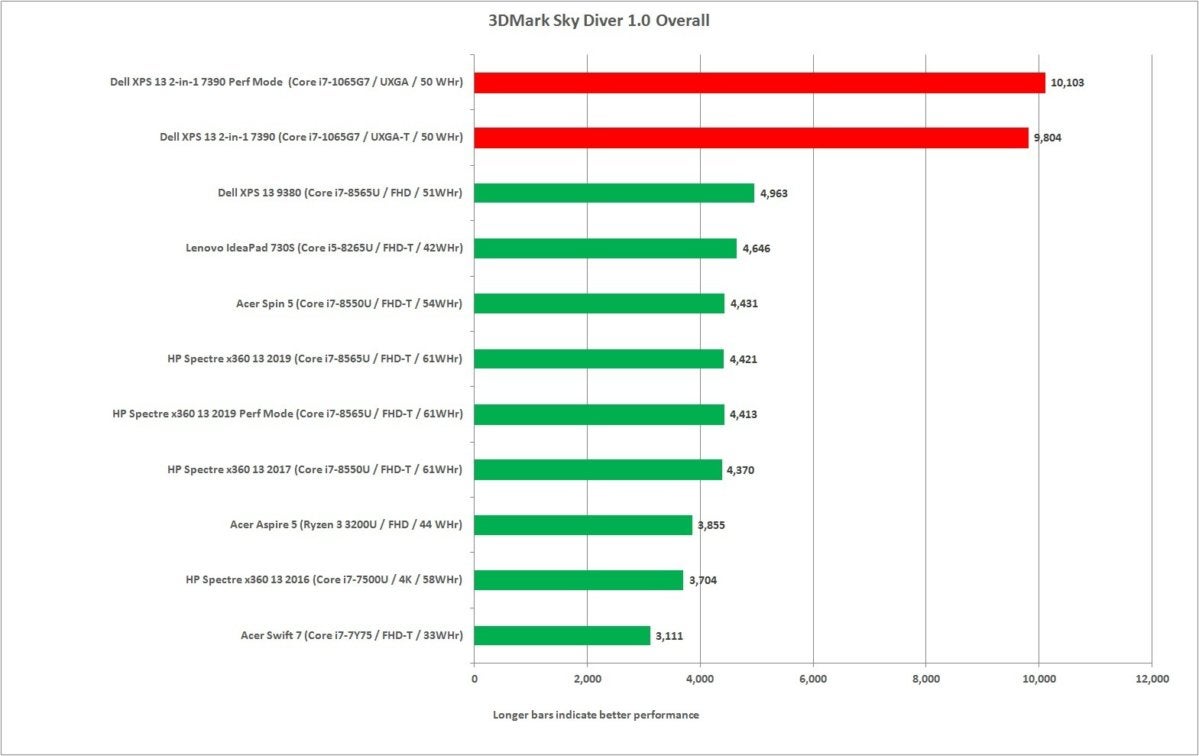 IDG
IDG The Iris Plus graphics in Intel's 10th-gen, 10nm Core i7-1065G7 is no slump compared to aged graphics chips.
XPS 13 2-in-1 battery life sentence
Our last test is the all important battery life belt along. For this, we charge the battery to full and set the laptop in aeroplane mode, with earbuds obstructed into the audio port and the luminousness set to a fair 250 nits to 260 nits. We then iteration a 4K television until the laptop runs out of juice. Our run time was antitrust below 12 hours, likely thanks to the larger battery and slightly take down-firmness panel. That's rattling trade good, only slightly behind HP's Spectre x360 13t, whose "1-watt panel" continues to sidesplitter.
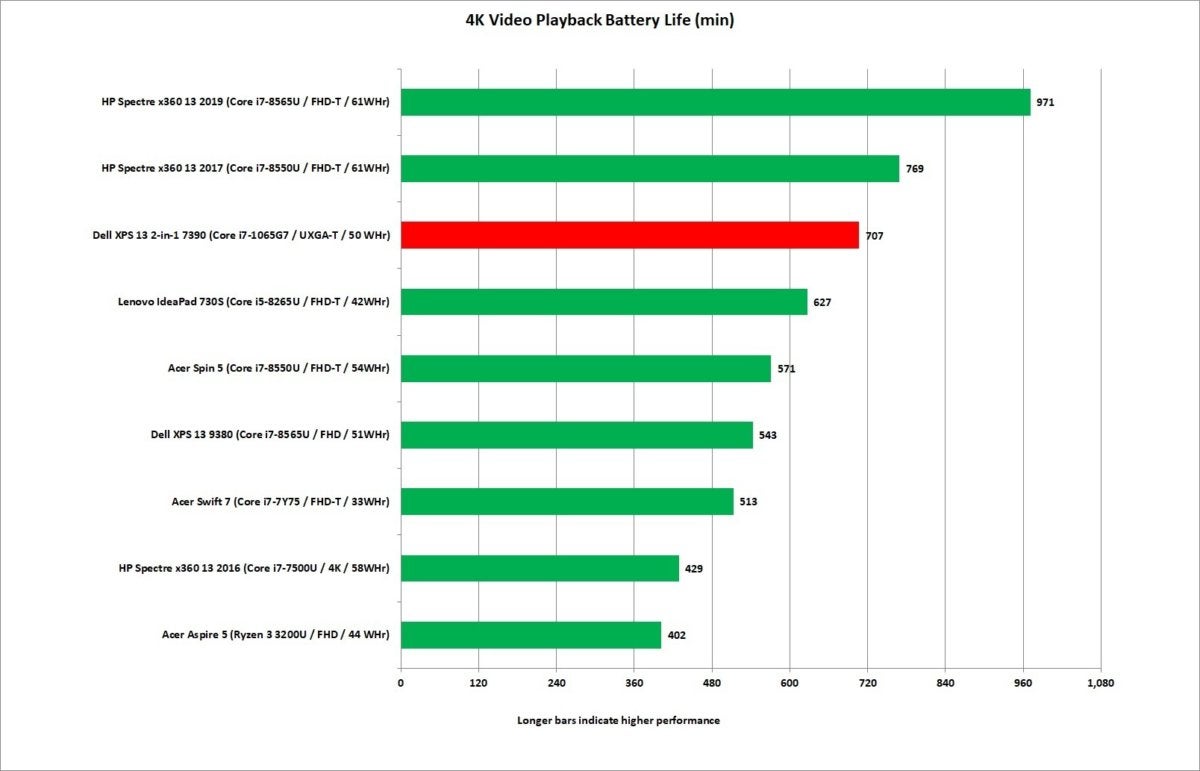 IDG
IDG Battery life is quite reputable, just non quite as good as the HP Spook x360 13t's.
XPS 13 2-in-1 storage card performance
One last test we'll throw at you is the laptop's microSD read and write speed. We don't typically care because it's an often-unused feature for most. And even when it is, few seconds North Korean won't bolt down you, will it?
With the Dell XPS 13 2-in-1's eonian SSD, though, the only way you'll ever ADHD storage to the laptop computer is by putting a memory carte in it. We wanted to see if the slot could substitute as a permanent depot option by, say, dropping in a 1TB microSD tease.
For our run we used a Sandisk 256GB Intense microSD card and metrical its sequential understand and write operation using Crystal Disk Mark 6. We then compared it to the Dell XPS 13 9380, and HP's Spectre x360 13t.
The light winner is the HP, which appears capable of reading from the scorecard at adjacent its maximum speed for most laptops. The computer storage card prat actually perform even faster reads and writes, but it requires a patented USB 3.0 Sandisk circuit card reader or a laptop computer that substantiate the feature article. So utmost, we know of no more laptops that do.
Some of the Dells come out to use the same circuit card proofreader comptroller, and some too get handily flummox by the Horsepower. It's not a dea-lbreaker, but we would make liked to watch better performance from the Dells, peculiarly if the company continues to drive toward permanent SSDs in its future laptops.
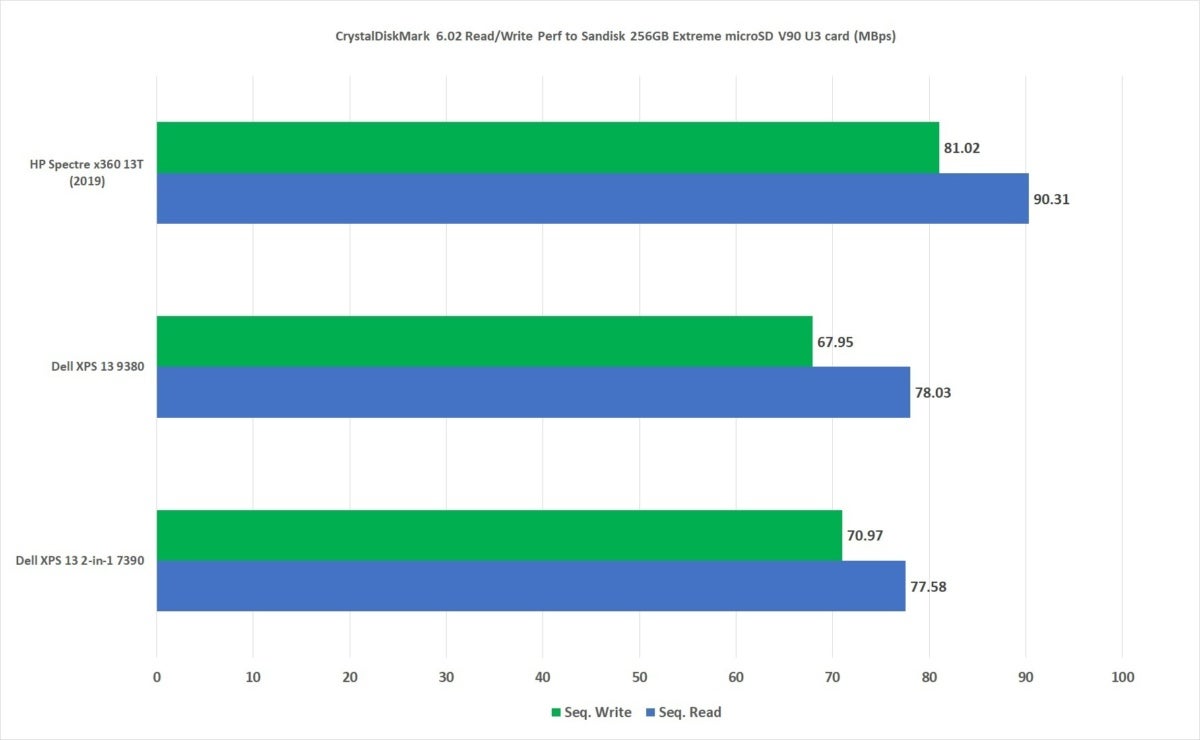 IDG
IDG The XPS 13 2-in-1 7390's microSD performance is good, but easily beaten by the HP Spectre x360 13t.
Conclusion
There's a lot to unwind on Dell's new XPS 13 2-in-1. The first is the execution front. Yes, you can debate (and we'd tend to jibe) that performance in an ultraportable laptop is secondary—but information technology's likewise something Worth paygrad. You are, after all, paying extra money for that Essence i7 over a Pentium for a reason, right?
Dell's reputation is to swing ou for the fences on performance, and the XPS 13 2-in-1 lives upward to its expectations. It's not only the fastest 2-in-1 we've seen, it's besides quicker overall than grapple designs including its celestial body sibling, the XPS 13 9380.
The thing is, as well the performance, there's just so more many. With its superior 16:10 aspect ratio screen that'll hit a blatant 500 nits, its touch and compose support (pen is ex gratia), and its ability to convert into an A-skeleton Oregon tablet mode, there's really lonesome two reasons to prefer the grapple ended the 2-in-1 XPS: the keyboard and the permanent SSD. In the grand dodging of things, we'd scarce deal with it, because we think over the translatable nature makes it a much more versatile laptop.
So yes, look at the XPS 13 9380 officially "killed" by its own sibling, the XPS 13 7390. We'd be negligent if we didn't remark that the XPS 13 gets to swing back when Dingle begins marketing its XPS 13 7390 with a 6-core 10th-gen CPU but the laptop relevant is Charles Frederick Worth to a higher degree two laptops in the bushes.
In the end, you get along a fast translatable actually capable of some play, with all the versatility that a 360-degree hinge brings. That's a rul for a unreal-perfect laptop.
Correction: Our original review incorrectly stated the aspect ratio of the Microsoft Surface laptops. PCWorld regrets the error.
Source: https://www.pcworld.com/article/398231/dell-xps-13-2-in-1-7390-review.html
Posted by: branchcolood.blogspot.com


0 Response to "Dell XPS 13 2-in-1 7390 Review: A convertible with very few compromises - branchcolood"
Post a Comment